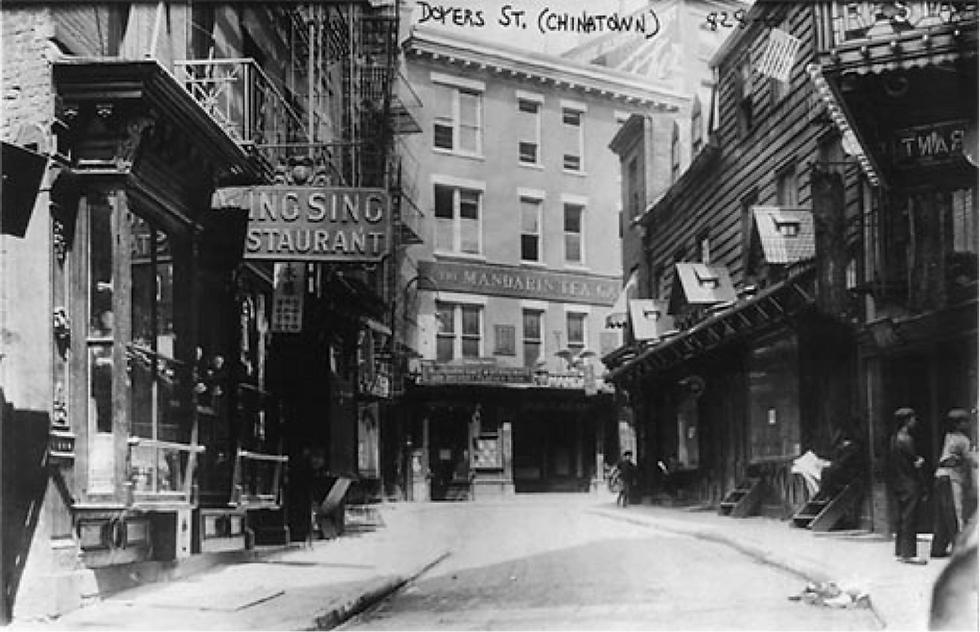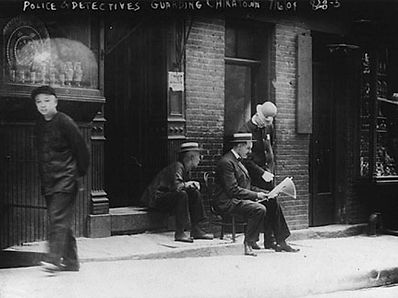Manhattan Chinatown
A Guide for Tourists
NYC Chinatown History
Below is a gallery describing the macro historical timeline of Chinatown NYC

Ah Ken, the first person officially known to have immigrated to New York Chinatown, is estimated to have moved there in 1840. He opened a cigar store on Park Row 1858. Photograph from: Library of Congress, Prints & Photographs Division, [LC-USZ62-69697]

In the 1870s, Chinese immigrants were fleeing from racial persecution on the West Coast and began arriving in New York City. A small Chinese community took root on Mott Street. Due to outside racism and the cultural divide, the Chinese immigrant community was segregated from the rest of New York City. Photograph from: http://upload.wikimedia.org/wikipedia/commons/a/ab/Doyers_Street_-_postcard_-_1898.jpg

On the conclusions page, you can find more information on the culture, holidays and amenities of Chinatown NYC today. To visit Conclusions click:

Ah Ken, the first person officially known to have immigrated to New York Chinatown, is estimated to have moved there in 1840. He opened a cigar store on Park Row 1858. Photograph from: Library of Congress, Prints & Photographs Division, [LC-USZ62-69697]
Chinatown NYC has a rich and diverse history. This slideshow serves to highlight some of the major events in a historical context.
If you would like to see the entire picture with the captions below, please click on the image to view the slideshow in full screen
Some interesting snapshots from the 20th century:
Police detectives guarding Chinatown, July 6, 1909.
One of the detectives is Chinese, and a policeman is reading the newspaper. There is another passerby on the street walking past the detectives.


Library of Congress, Prints & Photographs Division, [LC-USZ62-69697]
Intersection of Pell, and Doyers, circa 1900,
Library of Congress, Prints & Photographs Division, [LC-USZ62-69697]
Chinatown on Sunday -- Pell Street, 1899.(source: NYPL MMPCO)
Chinese folks who worked or lived outside of Chinatown would come to Chinatown on the weekends, to shop and to socialize.


Library of Congress, Prints & Photographs Division, [LC-USZ62-69697]
Free coffee at Bowery Mission for Unemployed, Jan 2, 1908.
Library of Congress, Prints & Photographs Division, [LC-USZ62-69697]

This short clip titled "NYC's Murder Alley - Doyers St., Chinatown - What Remains" explains how dangerous Doyers St was back in the 1900's
Library of Congress, Prints & Photographs Division, [LC-USZ62-69697]
Chinatown in the through the 20th and early 21st Century

NYC Chinatown Street, 1942

Photo: Courtesy of Charles W. Cushman Photograph Collection / Indiana University Archives
Chinese Store windows, 1942
Bayard Street in Manhattan's Chinatown, 1997

Pell Street, 2005

Photo: Courtesy of Charles W. Cushman Photograph Collection / Indiana University Archives
1 Doyers St, New York, 2013

Chinatown NYC Statistics
Major Chinatown Census Statistics at a Glance

Population Change Rates in Chinatown by Race and Age

Table found at:
Table found at: http://www.aafny.org/cic/briefs/Chinatownbrief.pdf
9/11 IMPACT
from Museum of Chinese in America: http://vimeo.com/14950778
"Take A Look: New York City Chinatown Post 9/11" by Kevin Lee
from Museum of Chinese in America:
"Take a Look" captures the thoughts and feelings of the residents of Chinatown after the World Trade Center disaster of September 11, 2001. This documentary was the first to cover the effects of 9/11 on the Chinese American community in New York City. It premiered at MOMA as part of an exhibition of filmed responses to 9/11. Up to that time, this community had been given no media coverage in spite of the personal and financial impact they suffered.
Pre 9/11
The Asian American Federation gathered data reflecting more than 10,000 workers’ experiences. The found the following:
There were 3,855 Chinese-owned and -operated businesses,
This included 1,423 retail stores and 241 wholesale outlets.
Among the retail establishments were more than 250 restaurants, as well as 500 specialty stores, such as jewelry, gift and apparel shops.
The Federation counted 35 bank branches in the neighborhood, with total deposits exceeding $5.44 billion.
Chinatown also had 246 garment factories, representing one-fifth of all garment shops in Manhattan and employing nearly 14,000 workers.
Post 9/11
For eight days following the attack, Chinatown south of Canal Street was a “frozen zone” in which all vehicular and non-residential pedestrian traffic was prohibited; and, for nearly two months.
Chinatown’s garment industry lost an estimated $490 million and more than one-fourth of the neighborhood’s clothing factories closed in the year after September 11th.
,The studies found, nearly three-quarters of Chinatown workers were laid off after September 11th, and one-quarter of the neighborhood’s employees (close to 8,000 workers) were still jobless three months later.
Chinatown suffered inordinate economic, social and physical damage in the wake of September 11th.. The quality of life for Chinatown residents has fallen sharply from the already-low levels reflected in 2000 census data.
Data and Statistics found at: http://www.aafny.org/cic/briefs/Chinatownbrief.pdf